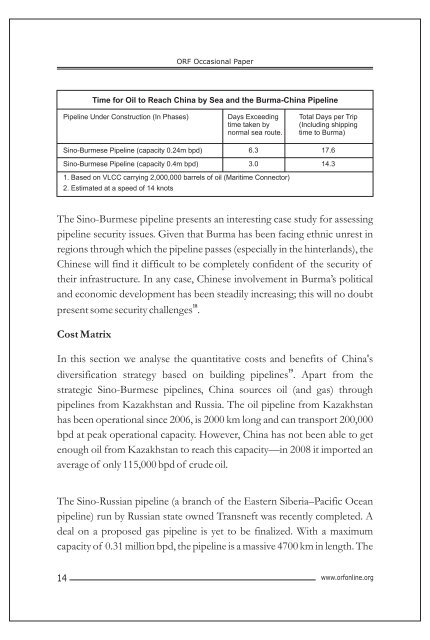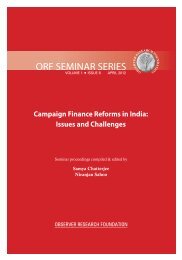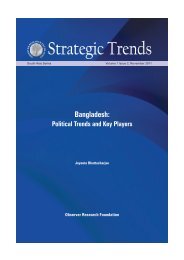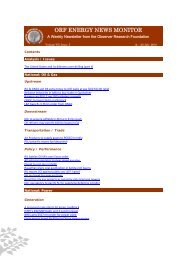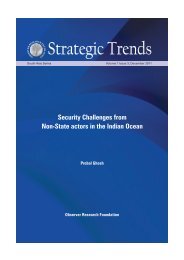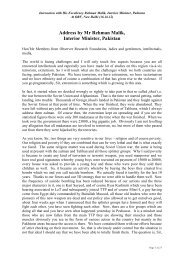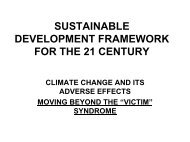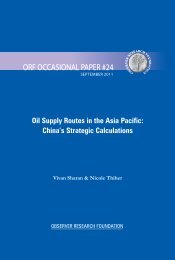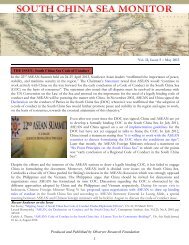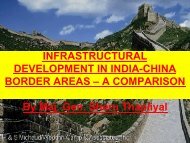Oil Supply Routes in the Asia Pacific: China's Strategic Calculations
Oil Supply Routes in the Asia Pacific: China's Strategic Calculations
Oil Supply Routes in the Asia Pacific: China's Strategic Calculations
You also want an ePaper? Increase the reach of your titles
YUMPU automatically turns print PDFs into web optimized ePapers that Google loves.
ORF Occasional Paper<br />
Time for <strong>Oil</strong> to Reach Ch<strong>in</strong>a by Sea and <strong>the</strong> Burma-Ch<strong>in</strong>a Pipel<strong>in</strong>e<br />
Pipel<strong>in</strong>e Under Construction (In Phases)<br />
Days Exceed<strong>in</strong>g<br />
time taken by<br />
normal sea route.<br />
Total Days per Trip<br />
(Includ<strong>in</strong>g shipp<strong>in</strong>g<br />
time to Burma)<br />
S<strong>in</strong>o-Burmese Pipel<strong>in</strong>e (capacity 0.24m bpd)<br />
S<strong>in</strong>o-Burmese Pipel<strong>in</strong>e (capacity 0.4m bpd)<br />
6.3 17.6<br />
3.0 14.3<br />
1. Based on VLCC carry<strong>in</strong>g 2,000,000 barrels of oil (Maritime Connector)<br />
2. Estimated at a speed of 14 knots<br />
The S<strong>in</strong>o-Burmese pipel<strong>in</strong>e presents an <strong>in</strong>terest<strong>in</strong>g case study for assess<strong>in</strong>g<br />
pipel<strong>in</strong>e security issues. Given that Burma has been fac<strong>in</strong>g ethnic unrest <strong>in</strong><br />
regions through which <strong>the</strong> pipel<strong>in</strong>e passes (especially <strong>in</strong> <strong>the</strong> h<strong>in</strong>terlands), <strong>the</strong><br />
Ch<strong>in</strong>ese will f<strong>in</strong>d it difficult to be completely confident of <strong>the</strong> security of<br />
<strong>the</strong>ir <strong>in</strong>frastructure. In any case, Ch<strong>in</strong>ese <strong>in</strong>volvement <strong>in</strong> Burma’s political<br />
and economic development has been steadily <strong>in</strong>creas<strong>in</strong>g; this will no doubt<br />
18<br />
present some security challenges .<br />
Cost Matrix<br />
In this section we analyse <strong>the</strong> quantitative costs and benefits of Ch<strong>in</strong>a's<br />
19<br />
diversification strategy based on build<strong>in</strong>g pipel<strong>in</strong>es . Apart from <strong>the</strong><br />
strategic S<strong>in</strong>o-Burmese pipel<strong>in</strong>es, Ch<strong>in</strong>a sources oil (and gas) through<br />
pipel<strong>in</strong>es from Kazakhstan and Russia. The oil pipel<strong>in</strong>e from Kazakhstan<br />
has been operational s<strong>in</strong>ce 2006, is 2000 km long and can transport 200,000<br />
bpd at peak operational capacity. However, Ch<strong>in</strong>a has not been able to get<br />
enough oil from Kazakhstan to reach this capacity—<strong>in</strong> 2008 it imported an<br />
average of only 115,000 bpd of crude oil.<br />
The S<strong>in</strong>o-Russian pipel<strong>in</strong>e (a branch of <strong>the</strong> Eastern Siberia–<strong>Pacific</strong> Ocean<br />
pipel<strong>in</strong>e) run by Russian state owned Transneft was recently completed. A<br />
deal on a proposed gas pipel<strong>in</strong>e is yet to be f<strong>in</strong>alized. With a maximum<br />
capacity of 0.31 million bpd, <strong>the</strong> pipel<strong>in</strong>e is a massive 4700 km <strong>in</strong> length. The<br />
14<br />
www.orfonl<strong>in</strong>e.org


